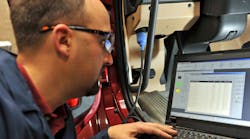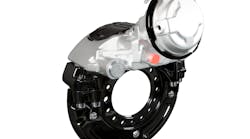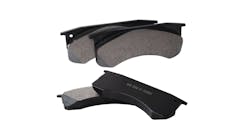All signs indicate that in a few short years, initial production of large electric commercial vehicles will be a reality in North America.
Original equipment manufacturers, teaming with partners like Bendix, are developing the architecture for these vehicles with an expected rollout by 2021 or 2022. As the industry speeds its drive toward increased electrification, fleets soon will be able to order heavy duty electric vehicles in quantity.
Engineers are working out platform details, but enough key pieces are in place to gain a big-picture understanding of what those changes will look like. Some vehicle parts will become easier to maintain because electrification will give them the ability to diagnose themselves. Technology will be added, carrying with it new challenges.
Electric vehicles will also impact a heavy duty truck’s braking components. Let’s take a high-level look at how electrification will likely affect the maintenance of air management, brake control, and wheel-end systems.
Air management
In the absence of a diesel engine, components and accessories that rely on that engine for power will become electrically driven.
The compressor is among these components. Driving the compressor electrically means adding a motor to the brake system. That motor may be 48V, but it will more likely be higher voltage, from 400V to 1,000V. High-voltage systems involve unique maintenance practices and typically require specialized training.
Technicians will also need to be aware of a new, separate filter for the compressor, which no longer can utilize the engine oil and air filter as part of its filtering process. Today, compressors are cooled with lubrication that is shared with the engine. Electrically driven compressors will require a new cooling method – possibly through liquid cooling. This adds another maintenance factor that doesn’t currently exist.
Rather than separate motors, a single electric motor may end up driving engine-mounted accessories such as the air conditioning and power steering, in addition to the air compressor. Technicians must become familiar with whatever configuration is chosen.
The air dryer is the next step in the system. In an electric vehicle, the air dryer will use a solenoid or electronic control unit (ECU) to control the system when it is purging. As a smart component, it will add a monitoring element that assesses the health of the system – such as communicating cartridge life and air system leakage. These advantages may make maintenance easier than it is today.
The same can be said of the air governor, which determines when a compressor builds air pressure. Functioning as part of an electric vehicle, an intelligent air governor will contribute added features and prognostic capabilities to the air brake system – potentially assisting maintenance efforts.
Brake control
The probability is high that electronic braking systems (EBS) will emerge as the base brake control system. If not EBS, then the addition of electronically controlled brake valves may be added to the current anti-lock braking system (ABS). While EBS has been in production for 20 years in Europe, ABS is still prevalent for North American vehicles.
Now, the combination of automated driving and electrification is causing the industry to reconsider ABS versus EBS. ABS is an intervention system which electronically activates only periodically to limit locking of the wheels when braking, limits wheel spin-up with traction control, and provides individual wheel braking to maintain vehicle stability. EBS controls the braking pressure electronically on every stop.
Today’s brake control uses pneumatic valves with solenoids. In EBS-based electric vehicles, valves that have ECUs will be mounted on the pneumatic valves, requiring technicians to make greater use of diagnostic software to service the brake control. These valves may include electronic park brake valves.
In the case of some EBS valves, additional flashing – or reprogramming – may be needed to properly position the valve on the vehicle. Technicians will also need to be aware of the EBS system’s stroke sensing sensors in the footbrake.
Electric vehicles, no longer relying on a diesel engine and traditional drivetrain, will increasingly use electric motors mounted on each axle. Some braking and deceleration will be handled by these motors. However, the electrified powertrain will not replace the traditional air brake system, which will remain on electric vehicles. Today, an electric drivetrain is unable to meet the legal requirement of stopping the vehicle if power is lost, nor is it able to absorb enough energy adequately in an emergency stop.
The traditional system will not go away, and brakes will not get smaller. On an electric vehicle, the backup pneumatic system may not be used often, but when needed it must be there. All of which explains why a properly maintained air brake system remains critically important.
Electric vehicles will not “brake by wire,” or through electronic signals. When applied, brakes will use air, with the electronics in place to better control the valves. If something goes wrong with the electronics, brake control must be ready to operate like an air system today – an important consideration for maintenance operations.
Wheel ends
A key change at the wheel ends is likely to be in the friction couple. With electric vehicles, the brakes are expected to be used less, as the electric motors take on more of the typical brake work. Accordingly, a different type of friction will be needed – a formulation that will clean itself more and, in the terminology, resist “going to sleep” from reduced usage, yet be able to maintain stopping distance during hard deceleration braking events.
As noted earlier, the brakes must always be in top working condition. It will be the obligation of the maintenance team to ensure the wheel end components are always ready.
Conclusion
Some electric vehicle manufacturers are also looking to use electrified vehicles as autonomous vehicles. This has implications for maintenance as well, because – like all commercial vehicles that require some level of redundancy – autonomous vehicles also require redundancy, or complementary systems to ensure that multiple functions, including braking, will continue to work if the primary system has an issue.
While the commercial vehicle landscape continues its evolutionary path, the central importance of maintenance will remain integral for the trucks of tomorrow.
Kevin Romanchok is the director – eMobility / new business development for Bendix Commercial Vehicle Systems LLC. In his almost 20 years at Bendix, Romanchok has led the Electronics and Actuation business units, driving the release and growth of multiple products, from stability to data management systems. As director of the company’s eMobility initiative, he now leads product and customer strategies, along with new business development and M&A efforts. Bendix Commercial Vehicle Systems, a member of the Knorr-Bremse Group, develops and supplies leading-edge active safety technologies, energy management solutions, and air brake charging and control systems and components under the Bendix brand name for medium and heavy duty trucks, tractors, trailers, buses, and other commercial vehicles throughout North America.






